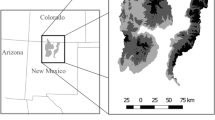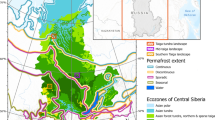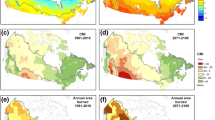Abstract
Content
Changing aspen distribution in response to climate change and fire is a major focus of biodiversity conservation, yet little is known about the potential response of aspen to these two driving forces along topoclimatic gradients.
Objective
This study is set to evaluate how aspen distribution might shift in response to different climate-fire scenarios in a semi-arid montane landscape, and quantify the influence of fire regime along topoclimatic gradients.
Methods
We used a novel integration of a forest landscape succession and disturbance model (LANDIS-II) with a fine-scale climatic water deficit approach to simulate dynamics of aspen and associated conifer and shrub species over the next 150 years under various climate-fire scenarios.
Results
Simulations suggest that many aspen stands could persist without fire for centuries under current climate conditions. However, a simulated 2–5 °C increase in temperature caused a substantial reduction of aspen coverage at lower elevations and a modest increase at upper elevations, leading to an overall reduction of aspen range at the landscape level. Increasing fire activity may favor aspen increase at its upper elevation limits adjacent to coniferous forest, but may also favor reduction of aspen at lower elevation limits adjacent to xeric shrubland.
Conclusions
Our study highlights the importance of incorporating fine-scale terrain effects on climatic water deficit and ecohydrology when modeling species distribution response to climate change. This modeling study suggests that climate mitigation and adaptation strategies that use fire would benefit from consideration of spatial context at landscape scales.






Similar content being viewed by others
References
Abatzoglou JT, Kolden CA (2011) Climate change in western US deserts: potential for increased wildfire and invasive annual grasses. Rangel Ecol Manag 64(5):471–478
Aber JD, Ollinger SV, Fédérer CA, Reich PB, Goulden ML, Kicklighter DW, Lathrop RG (1995) Predicting the effects of climate change on water yield and forest production in the northeastern United States. Clim Res 5(3):207–222
Allen CD, Macalady AK, Chenchouni H, Bachelet D, McDowell N, Bennetier M, Kitzberger T, Vennetier M, Kitzberger T, Breshears DB, Hogg EH, Gonzalez P, Fensham R, Zhang Z, Castro J, Demidova N, Lim LH, Allard G, Running SW, Semerci A, Cobb N (2010) A global overview of drought and heat-induced tree mortality reveals emerging climate change risks for forests. For Ecol Manag 259(4):660–684
Anderegg LD, Anderegg WR, Abatzoglou J, Hausladen AM, Berry JA (2013) Drought characteristics’ role in widespread aspen forest mortality across Colorado, USA. Glob Change Biol 19:1526–1537
Araújo MB, Luoto M (2007) The importance of biotic interactions for modelling species distributions under climate change. Glob Ecol Biogeogr 16(6):743–753
Ashcroft MB, Gollan JR, Warton DI, Ramp D (2012) A novel approach to quantify and locate potential microrefugia using topoclimate, climate stability, and isolation from the matrix. Glob Change Biol 18(6):1866–1879
Baker WL (2009) Fire ecology in Rocky Mountain landscapes. Island Press, Washington, D.C.
Beck JL, Peek JM, Strand EK (2006) Estimates of elk summer range nutritional carrying capacity constrained by probabilities of habitat selection. J Wildl Manag 70(1):283–294
Beckage B, Osborne B, Gavin DG, Pucko C, Siccama T, Perkins T (2008) A rapid upward shift of a forest ecotone during 40 years of warming in the Green Mountains of Vermont. Proc Natl Acad Sci 105(11):4197–4202
Bell DM, Bradford JB, Lauenroth WK (2014) Mountain landscapes offer few opportunities for high-elevation tree species migration. Glob Change Biol 20:1441–1451
Bond WJ, Keeley JE (2005) Fire as a global ‘herbivore’: the ecology and evolution of flammable ecosystems. Trends Ecol Evol 20(7):387–394
Breshears DD, Cobb NS, Rich PM, Price KP, Allen CD, Balice RG, Romme WH, Kastens JH, Floyd ML, Belnap J, Anderson JJ, Myers OB, Meyer CW (2005) Regional vegetation die-off in response to global-change-type drought. Proc Natl Acad Sci 102(42):15144–15148
Breshears DD, Huxman TE, Adams HD, Zou CB, Davison JE (2008) Vegetation synchronously leans upslope as climate warms. Proc Natl Acad Sci 105(33):11591–11592
Calder WJ, Horn KJ, Clair SBS (2011) Conifer expansion reduces the competitive ability and herbivore defense of aspen by modifying light environment and soil chemistry. Tree Physiol 31(6):582–591
Chambers JC, Roundy BA, Blank RR, Meyer SE, Whittaker A (2007) What makes Great Basin sagebrush ecosystems invasible by Bromus tectorum? Ecol Monogr 77(1):117–145
Chen I-C, Hill JK, Ohlemüller R, Roy DB, Thomas CD (2011) Rapid range shifts of species associated with high levels of climate warming. Science 333(6045):1024–1026
Chong GW, Simonson SE, Stohlgren TJ, Kalkhan MA (2001) Biodiversity: aspen stands have the lead, but will nonnative species take over? USDA Forest Service Proceedings RMRS-P-18
Clair SBS, Guyon J, Donaldson J (2010) Quaking aspen’s current and future status in western North America: the role of succession, climate, biotic agents and its clonal nature. Progress in Botany 71, Springer, pp 371–400
Crimmins SM, Dobrowski SZ, Greenberg JA, Abatzoglou JT, Mynsberge AR (2011) Changes in climatic water balance drive downhill shifts in plant species’ optimum elevations. Science 331(6015):324–327
Daly C, Halbleib M, Smith JI, Gibson WP, Doggett MK, Taylor GH, Pasteris PP (2008) Physiographically sensitive mapping of climatological temperature and precipitation across the conterminous United States. Int J Climatol 28(15):2031–2064
Daubenmire RF (1943) Vegetational zonation in the Rocky Mountains. Bot Rev 9(6):325–393
Davies GM, Bakker JD, Dettweiler-Robinson E, Dunwiddie PW, Hall SA, Downs J, Evans J (2012) Trajectories of change in sagebrush steppe vegetation communities in relation to multiple wildfires. Ecol Appl 22(5):1562–1577
Dobrowski SZ (2011) A climatic basis for microrefugia: the influence of terrain on climate. Glob Change Biol 17(2):1022–1035
Flannigan MD, Krawchuk MA, de Groot WJ, Wotton M, Gowman LM (2009) Implications of changing climate for global wildland fire. Int J Wildland Fire 18(5):483–507
Franklin J, McCullough P, Gray C (2000) Terrain variables used for predictive mapping of vegetation communities in Southern California. In: Wilson JP, Gallant JC (eds) Terrain analysis: principles and applications. Wiley, Hoboken
Gustafson EJ, Sturtevant BR (2012) Modeling Forest Mortality Caused by Drought Stress: Implications for Climate Change. Ecosystems:1-15
Gustafson EJ, Shvidenko AZ, Sturtevant BR, Scheller RM (2010) Predicting global change effects on forest biomass and composition in south-central Siberia. Ecol Appl 20(3):700–715
Gustafson EJ, Kubiske ME, Sturtevant BR, Miranda BR (2013) Scaling Aspen-FACE experimental results to century and landscape scales. Landscape Ecol 28(9):1785–1800
Hanna P, Kulakowski D (2012) The influences of climate on aspen dieback. For Ecol Manage 274:91–98
Hawbaker TJ, Radeloff VC, Stewart SI, Hammer RB, Keuler NS, Clayton MK (2013) Human and biophysical influences on fire occurrence in the United States. Ecol Appl 23(3):565–582
Hessl AE, Graumlich LJ (2002) Interactive effects of human activities, herbivory and fire on quaking aspen (Populus tremuloides) age structures in western Wyoming. J Biogeogr 29(7):889–902
Heyerdahl EK, Brubaker LB, Agee J (2001) Spatial controls of historical fire regimes: a multiscale example from the interior west, USA. Ecology 82(3):660–678
Hughes L (2000) Biological consequences of global warming: is the signal already apparent? Trends Ecol Evol 15(2):56–61
IPCC (2007) Climate Change 2007: The physical science basis. Summary for policymakers. Contribution of working group I to the fourth assessment report. The Intergovernmental Panel on Climate Change. http://www.ipcc.ch/SPM2feb07.pdf
Iverson LR, McKenzie D (2013) Tree-species range shifts in a changing climate: detecting, modeling, assisting. Landscape Ecol 28(5):879–889
Karam SL, Weisberg PJ, Scheller RM, Johnson DW, Miller WW (2013) Development and evaluation of a nutrient cycling extension for the LANDIS-II landscape simulation model. Ecol Model 250:45–57
Kashian DM, Romme WH, Regan CM (2007) Reconciling divergent interpretations of quaking aspen decline on the northern Colorado Front Range. Ecol Appl 17(5):1296–1311
Kay CE (1993) Aspen seedlings in recently burned areas of Grand Teton and Yellowstone National Parks. Northwest Sci 67(2):94–104
Kay CE (1997) Is aspen doomed? J Forest 95(5):4
Kaye MW, Binkley D, Stohlgren TJ (2005) Effects of conifers and elk browsing on quaking aspen forests in the central Rocky Mountains, USA. Ecol Appl 15(4):1284–1295
Keeley JE, Pausas JG, Rundel PW, Bond WJ, Bradstock RA (2011) Fire as an evolutionary pressure shaping plant traits. Trends Plant Sci 16(8):406–411
Kelly AE, Goulden ML (2008) Rapid shifts in plant distribution with recent climate change. Proc Natl Acad Sci 105(33):11823–11826
Keppel G, Van Niel KP, Wardell-Johnson GW, Yates CJ, Byrne M, Mucina L, Schut AGT, Hopper SD, Franklin SE (2012) Refugia: identifying and understanding safe havens for biodiversity under climate change. Glob Ecol Biogeogr 21(4):393–404
Krawchuk MA, Moritz MA, Parisien MA, Van Dorn J, Hayhoe K (2009) Global pyrogeography: the current and future distribution of wildfire. PLoS One 4(4):e5102
Kulakowski D, Veblen TT, Kurzel BP (2006) Influences of infrequent fire, elevation and pre-fire vegetation on the persistence of quaking aspen (Populus tremuloides Michx.) in the Flat Tops area, Colorado, USA. J Biogeogr 33(8):1397–1413
Lenihan JM, Bachelet D, Neilson RP, Drapek R (2008) Response of vegetation distribution, ecosystem productivity, and fire to climate change scenarios for California. Clim Change 87:215–230
Lenoir J, Gegout JC, Marquet PA, De Ruffray P, Brisse H (2008) A significant upward shift in plant species optimum elevation during the 20th century. Science 320(5884):1768–1771
Lenoir J, Gégout JC, Guisan A, Vittoz P, Wohlgemuth T, Zimmermann NE, Dullinger S, Pauli H, Willner W, Svenning JC (2010) Going against the flow: potential mechanisms for unexpected downslope range shifts in a warming climate. Ecography 33(2):295–303
Linares JC, Camarero JJ, Carreira JA (2009) Interacting effects of changes in climate and forest cover on mortality and growth of the southernmost European fir forests. Glob Ecol Biogeogr 18(4):485–497
Littell JS, McKenzie D, Peterson DL, Westerling AL (2009) Climate and wildfire area burned in western US ecoprovinces, 1916–2003. Ecol Appl 19(4):1003–1021
Littell JS, Oneil EE, McKenzie D, Hicke JA, Lutz JA, Norheim RA, Elsner MM (2010) Forest ecosystems, disturbance, and climatic change in Washington State, USA. Clim Change 102(1–2):129–158
Littell JS, Peterson DL, Millar CI, O’Halloran KA (2012) US National Forests adapt to climate change through Science-Management partnerships. Clim Change 110(1–2):269–296
Loehle C, LeBlanc D (1996) Model-based assessments of climate change effects on forests: a critical review. Ecol Model 90(1):1–31
Long JN, Mock K (2012) Changing perspectives on regeneration ecology and genetic diversity in western quaking aspen: implications for silviculture. Can J For Res 42(12):2011–2021
Lutz JA, van Wagtendonk JW, Franklin JF (2010) Climatic water deficit, tree species ranges, and climate change in Yosemite National Park. J Biogeogr 37(5):936–950
Mack MC, D’Antonio CM (1998) Impacts of biological invasions on disturbance regimes. Trends Ecol Evol 13(5):195–198
Maurer EP (2007) Uncertainty in hydrologic impacts of climate change in the Sierra Nevada, California, under two emissions scenarios. Clim Change 82(3–4):309–325
McCool SF (2001) Quaking aspen and the human experience: dimensions, issues, and challenges. In: Sustaining aspen in western landscapes: Symposium Proceedings. RMRS-P-18. Grand Junction, CO: US Dept. of Agriculture, Rocky Mountain Research Station, Forest Service Proceedings
McCune B, Keon D (2002) Equations for potential annual direct incident radiation and heat load. J Veg Sci 13(4):603–606
Mladenoff DJ, He HS (1999) Design, behavior and application of LANDIS, an object-oriented model of forest landscape disturbance and succession. Spatial modeling of forest landscape change: approaches and applications. Cambridge University Press, Cambridge, UK, pp 125–162
Morin X, Thuiller W (2009) Comparing niche-and process-based models to reduce prediction uncertainty in species range shifts under climate change. Ecology 90(5):1301–1313
Post WM, Pastor J (1996) LINKAGES—an individual-based forest ecosystem model. Clim Change 34(2):253–261
Rehfeldt GE, Crookston NL, Warwell MV, Evans JS (2006) Empirical analyses of plant-climate relationships for the western United States. Int J Plant Sci 167(6):1123–1150
Rehfeldt GE, Ferguson DE, Crookston NL (2009) Aspen, climate, and sudden decline in western USA. For Ecol Manage 258(11):2353–2364
Reich P, Ellsworth D, Kloeppel B, Fownes J, Gower S (1990) Vertical variation in canopy structure and CO2 exchange of oak-maple forests: influence of ozone, nitrogen, and other factors on simulated canopy carbon gain. Tree Physiology 7(1-2-3-4):329–345
Rogers PC, Eisenberg C, Clair S (2013) Resilience in Quaking Aspen: recent advances and future needs. For Ecol Manag 299:1–5
Romme WH, Turner MG (1991) Implications of global climate change for biogeographic patterns in the Greater Yellowstone Ecosystem. Conserv Biol 5(3):373–386
Romme WH, Turner MG, Tuskan GA, Reed RA (2005) Establishment, persistence, and growth of aspen (Populus tremuloides) seedlings in Yellowstone National Park. Ecology 86(2):404–418
Scheller RM, Mladenoff DJ (2004) A forest growth and biomass module for a landscape simulation model, LANDIS: design, validation, and application. Ecol Model 180(1):211–229
Scheller RM, Mladenoff DJ (2005) A spatially interactive simulation of climate change, harvesting, wind, and tree species migration and projected changes to forest composition and biomass in northern Wisconsin. USA. Glob Change Biol 11(2):307–321
Scheller RM, Domingo JB, Sturtevant BR, Williams JS, Rudy A, Gustafson EJ, Mladenoff DJ (2007) Design, development, and application of LANDIS-II, a spatial landscape simulation model with flexible temporal and spatial resolution. Ecol Model 201(3):409–419
Schlaepfer DR, Lauenroth WK, Bradford JB (2012) Consequences of declining snow accumulation for water balance of mid-latitude dry regions. Glob Change Biol 18(6):1988–1997
Schlesinger WH, DeLucia EH, Billings W (1989) Nutrient-use efficiency of woody plants on contrasting soils in the western Great Basin, Nevada. Ecology 70(1):105–113
Schoennagel T, Veblen TT, Romme WH (2004) The interaction of fire, fuels, and climate across Rocky Mountain forests. Bioscience 54(7):661–676
Schumacher S, Bugmann H (2006) The relative importance of climatic effects, wildfires and management for future forest landscape dynamics in the Swiss Alps. Glob Change Biol 12(8):1435–1450
Shinneman DJ, Palik BJ, Cornett MW (2012) Can landscape-level ecological restoration influence fire risk? A spatially-explicit assessment of a northern temperate-southern boreal forest landscape. For Ecol Manage 274:126–135
Shinneman DJ, Baker WL, Rogers PC, Kulakowski D (2013) Fire regimes of quaking aspen in the Mountain West. For Ecol Manag 299(1):22–34
Smith WK, Germino MJ, Hancock TE, Johnson DM (2003) Another perspective on altitudinal limits of alpine timberlines. Tree Physiol 23(16):1101–1112
Smith EA, O’Loughlin D, Buck JR, St Clair SB (2011) The influences of conifer succession, physiographic conditions and herbivory on quaking aspen regeneration after fire. For Ecol Manag 262(3):325–330
Stephenson N (1998) Actual evapotranspiration and deficit: biologically meaningful correlates of vegetation distribution across spatial scales. J Biogeogr 25(5):855–870
Strand EK, Vierling LA, Bunting SC (2009a) A spatially explicit model to predict future landscape composition of aspen woodlands under various management scenarios. Ecol Model 220(2):175–191
Strand EK, Vierling LA, Bunting SC, Gessler PE (2009b) Quantifying successional rates in western aspen woodlands: current conditions, future predictions. For Ecol Manag 257(8):1705–1715
Sturtevant BR, Scheller RM, Miranda BR, Shinneman D, Syphard A (2009) Simulating dynamic and mixed-severity fire regimes: a process-based fire extension for LANDIS-II. Ecol Model 220(23):3380–3393
Syphard AD, Scheller RM, Ward BC, Spencer WD, Stritthold JR (2011) Simulating landscape-scale effects of fuels treatments in the Sierra Nevada, California, USA. Int J Wildland Fire 20(3):364–383
Temperli C, Bugmann HKM, Elkin C (2013) Cross-scale interactions among bark beetles, climate change and wind disturbances: a landscape modeling approach. Ecol Monogr 83:383–402
Ward BC, Mladenoff DJ, Scheller RM (2005) Simulating landscape-level effects of constraints to public forest regeneration harvests due to adjacent residential development in northern Wisconsin. For Sci 51(6):616–632
Weed AS, Ayres MP, Hicke J (2013) Consequences of climate change for biotic disturbances in North American forests. Ecol Monogr 83:441–470
Westerling AL, Turner MG, Smithwick EAH, Romme WH, Ryan MG (2011) Continued warming could transform Greater Yellowstone fire regimes by mid-21st century. Proc Natl Acad Sci 108(32):13165–13170
Worrall JJ, Marchetti SB, Egeland L, Mask RA, Eager T, Howell B (2010) Effects and etiology of sudden aspen decline in southwestern Colorado, USA. For Ecol Manag 260(5):638–648
Wright IJ, Reich PB, Westoby M, Ackerly DD, Baruch Z, Bongers F, Cavender-Bares J, Chapin T, Cornelissen JHC, Diemer M, Flexas J, Garnier E, Groom PK, Gulias J, Hikosaka K, Lamont BB, Lee T, Lee W, Lusk C, Midgley JL, Navas ML, Niinemets Ü, Oleksyn J, Osada N, Poorter H, Poot P, Prior L, Pyankov VI, Roumet C, Thomas SC, Tjoelker MG, Veneklaas EJ, Villar R (2004) The worldwide leaf economics spectrum. Nature 428(6985):821–827
Xu C, Gertner GZ, Scheller RM (2007) Potential effects of interaction between CO2 and temperature on forest landscape response to global warming. Glob Change Biol 13(7):1469–1483
Xu C, Gertner GZ, Scheller RM (2009) Uncertainties in the response of a forest landscape to global climatic change. Glob Change Biol 15(1):116–131
Yang J, He HS, Gustafson EJ (2004) A hierarchical fire frequency model to simulate temporal patterns of fire regimes in LANDIS. Ecol Model 180(1):119–133
Yang J, He HS, Shifley SR (2008) Spatial controls of occurrence and spread of wildfires in the Missouri Ozark Highlands. Ecol Appl 18(5):1212–1225
Zhu K, Woodall CW, Clark JS (2012) Failure to migrate: lack of tree range expansion in response to climate change. Glob Change Biol 18(3):1042–1052
Acknowledgments
Funding was provided by the U.S. Geological Survey National Climate Change and Wildlife Science Center (NCCWSC). Any use of trade, product, or firm names is for descriptive purposes only and does not imply endorsement by the U.S.G.S. We thank Steve Garman and two anonymous reviewers for helpful reviews that helped us improve the manuscript.
Author information
Authors and Affiliations
Corresponding author
Electronic supplementary material
Below is the link to the electronic supplementary material.
Rights and permissions
About this article
Cite this article
Yang, J., Weisberg, P.J., Shinneman, D.J. et al. Fire modulates climate change response of simulated aspen distribution across topoclimatic gradients in a semi-arid montane landscape. Landscape Ecol 30, 1055–1073 (2015). https://doi.org/10.1007/s10980-015-0160-1
Received:
Accepted:
Published:
Issue Date:
DOI: https://doi.org/10.1007/s10980-015-0160-1




